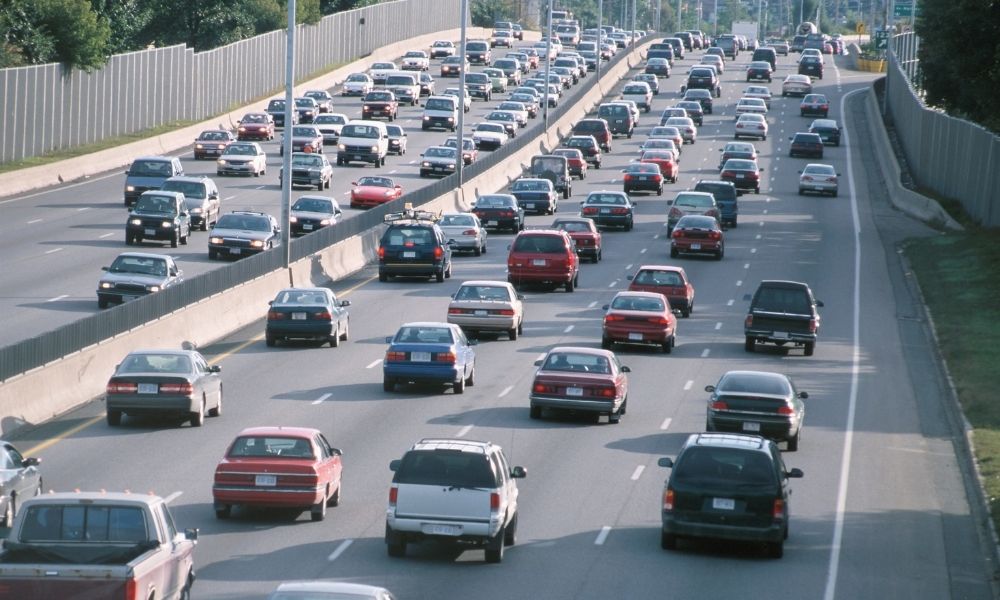Scared about driving on the highway?
We don’t blame you.
You are, after all, traveling along with a hundred other vehicles at high speed.
Well, we’re here to help.
In this article, we’re going to give you 7 helpful highway driving tips. These tips will help you overcome your fear of driving on the highway, as well as keep you safe while you’re at it.
So without further ado, let’s check out these highway driving tips.
1. It’s not as scary as you think

First things first, let’s clear the air once and for all — highway driving is not as dangerous as you think.
We get why you’re scared, though. It’s pretty common to be intimidated by driving on a highway.
Everyone is going fast. You can’t pull a stop whenever you feel like it. You have no choice but to keep driving until you get off the big road.
But what makes highways scary is also what makes them safer.
There are no intersections to be found. Cars are all going one way. There is less tailgating. There’s less decision-making involved.
We could go on and on.
Plus, everyone seems to be on the same page. There is a sense of camaraderie among drivers on highways — a unity that cannot be found on your usual roads.
2. Practice merging
Now that we’ve calmed you down a bit, it’s time to learn the most crucial highway driving skill: merging.
Before entering a highway, you have to learn how to merge.
One good way to practice merging on a highway is to do it during off-days. That is, you avoid the rush hour.
With not a lot of cars passing by, you’ll have an easier time working on your merging skills and, in turn, building your confidence.
Remember, always use your signals when joining the highway traffic from an entry ramp. This movement will inform the other drivers that you are merging.
Once you successfully enter the acceleration lane, the lane in which you’re given space to match the speed of the highway traffic, leave your signal on to let the other drivers know that you are joining the highway.
At this point, it should be easy to find a gap for your car so that you can enter the highway.
From the ramp to the highway, take glances at your side mirrors while merging to check on your blind spot.
3. Get comfortable with highway speed
Going fast can be scary for first-time highway drivers, even more so for newbie drivers. But this is something that takes time and practice. It pays to be patient.
Every highway always has an indicated speed limit. As a newbie, it’s perfectly fine to go 5-10mph under it. But try picking up the speed.
In no time, you’ll be comfortable hitting the indicated speed limit.
4. Use the right lane
Left lanes are typically called fast lanes because drivers use them to pass slower cars. Naturally, it’s a faster lane than the right lane.
It’s okay to take the right lane if you’re just starting. There’s no need to go on the left unless you intend to pass other cars or unless your destination requires that you take the left lane.
5. Take it slow with lane changing
In some cases, changing lanes on a highway is necessary for you to be able to get to where you want to be.
Changing lanes is relatively simple, mechanics-wise. But doing it safely and smoothly is a whole different thing.
The principles are the same when changing lanes on a city road vs. on a highway. You turn your signal on, check your rear and side mirrors, check your blind spot, and smoothly make the switch.
It may sound terrifying since all the cars are going fast, but you’ll get used to it in no time.
The key here, like with merging, is to practice. Time your practice during off-peak hours so you’ll encounter fewer cars. This way, you’ll gain more experience minus the worry of dealing with a ton of traffic.
Also, keep in mind the pavement markings. Solid lines mean you are not allowed to change lanes. Broken lines indicate you’re free to pass or switch lanes.
6. Look ahead, way ahead
It’s common for new drivers to look straight into what’s in front of them while driving, but cruising along a highway requires you to look further down the road.
Switching up your viewpoint is a good habit. Glance a bit on your speedometer to check your speed. Look ahead of you, and then look even further ahead.
Like all things, this comes down to practice.
7. If nothing works, consider getting help
Anxiety is a very common, widespread disorder. Some drivers will just short circuit when out on the road, especially on fast ones like highways. There is no shame in that.
Indeed, driving can be mentally and physically taxing. There are a lot of variables in play, and there is always the looming possibility of an accident.
If this is the case for you, the first step might be to seek guidance from a therapist. Cognitive Behavioral Therapy is a common treatment for anxiety disorders. It usually involves tuning into your deepest self to figure out why you think the way you do and how to rewire that.
Conclusion
Before facing your fears of driving on a highway, it’s always good to challenge your current mindset.
Is the highway even that dangerous?
Is it easier to go faster without worrying about intersections?
Once you decide you’re ready to conquer your fear, take things slowly. You won’t be able to perform merges and lane switches smoothly on the first try (unless you’re gifted.)
The key is to practice consistently and be gentle with yourself.
You can also follow these 7 helpful highway driving tips.
In no time, you won’t have to worry every time you enter a highway.
So start following these tips and getting used to the highway!
